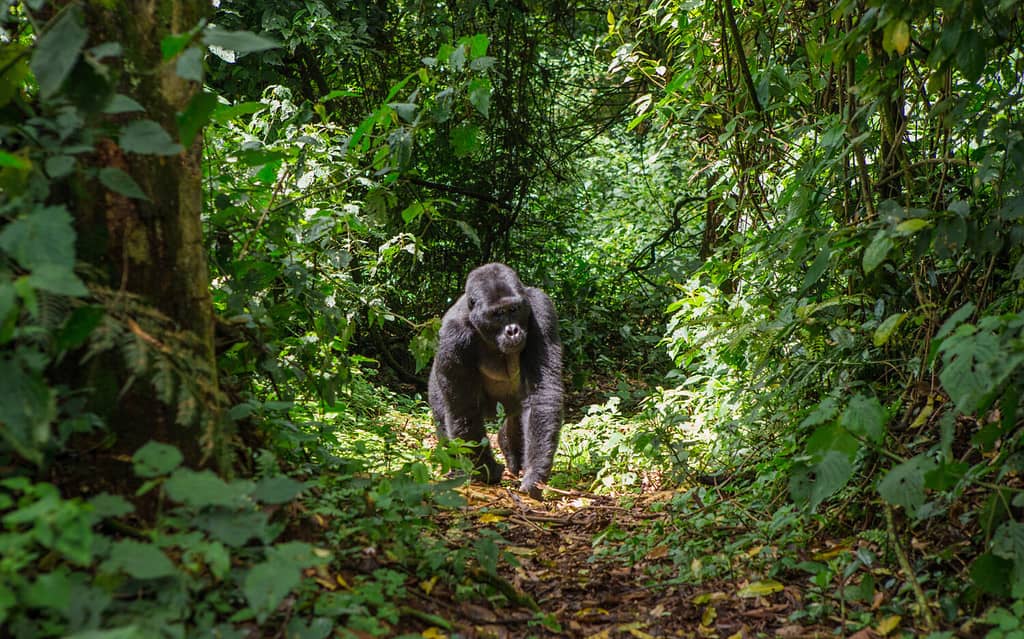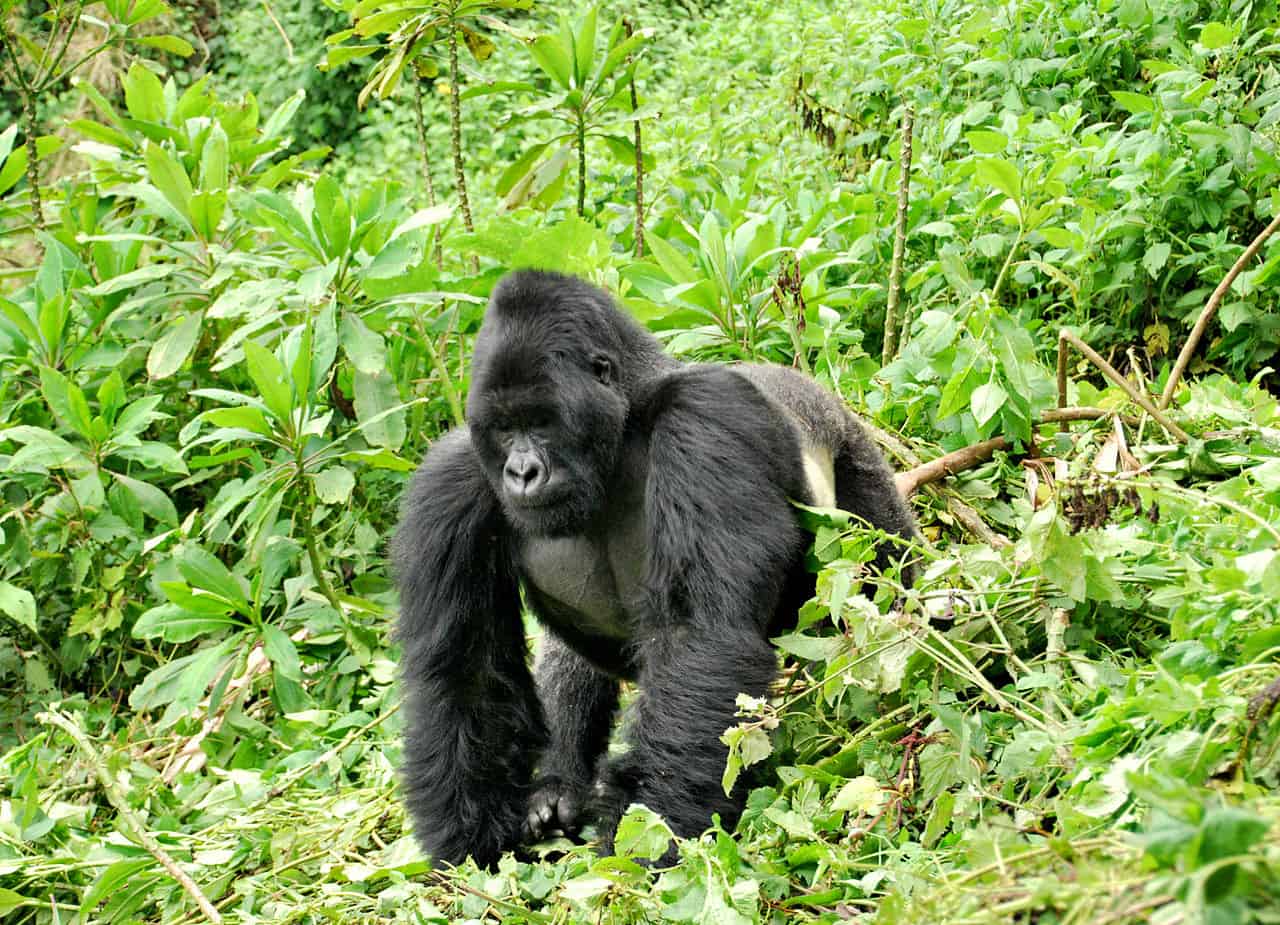Introduction
One of the most recognizable primates in the world is the gorilla. You’ve seen them everywhere, in TV shows and movies, at the zoo, stuffed animals, and more. Did you know that humans have a very similar DNA to that of gorillas, matching about 95 to 99% of their DNA? We share a lot more in common with these great apes than we realize.
However, one of the main problems gorillas face today is extinction. There are two different main species of gorillas: the western gorilla (Gorilla gorilla) and the eastern gorilla (Gorilla beringei). The International Union for Conservation of Nature (IUCN) has deemed both of these species as Critically Endangered.
There are five criteria that are a requirement to have the label Critically Endangered, given by the IUCN. The species must be facing population size reduction, reduction across a geographical range, population decline, and a high probability of extinction. Unfortunately, both species of gorilla face these problems, causing them to be Critically Endangered.
So why do gorillas now face extinction? How many gorillas are there in the world? Read on to find out what issues gorillas face today, and to learn about conservation efforts being led to help these great apes.
How Many Gorillas Are There in the World?

There are about 1,000 mountain gorillas in the world.
©GUDKOV ANDREY/Shutterstock.com
Both species of gorillas – the western gorilla and the eastern gorilla – are labeled Critically Endangered by the International Union for Conservation of Nature. The IUCN estimates there to be about 316,000 western gorillas and 5,000 eastern gorillas left in the world. These are the two main species of gorillas, and all subspecies are also considered Critically Endangered. However, the mountain gorilla (Gorilla beringei beringei) is one tier lower, and is labeled Endangered by the IUCN.
There are four subspecies of gorillas after the western and eastern gorillas. The two subspecies of the western gorilla are the western lowland gorilla (Gorilla gorilla gorilla) and the Cross River gorilla (Gorilla gorilla diehli). The two subspecies of the eastern gorilla are the mountain gorilla and the eastern lowland gorilla (Gorilla beringei graueri). The western lowland gorilla, Cross River gorilla, and eastern lowland gorilla are all Critically Endangered. Within these subspecies, there are not many in the world. Here’s a breakdown of how many gorillas remain within each subspecies.
| COMMON NAME | SCIENTIFIC NAME | HOW MANY ARE LEFT? | CONSERVATION STATUS |
| Western Gorilla | Gorilla gorilla | About 316,000 | Critically Endangered |
| Western Lowland Gorilla | Gorilla gorilla gorilla | About 100,000 | Critically Endangered |
| Cross River Gorilla | Gorilla gorilla diehli | About 200 to 300 | Critically Endangered |
| COMMON NAME | SCIENTIFIC NAME | HOW MANY ARE LEFT? | CONSERVATION STATUS |
| Eastern Gorilla | Gorilla beringei | Less than 6,000 | Critically Endangered |
| Mountain Gorilla | Gorilla beringei beringei | About 1,000 | Endangered |
| Eastern Lowland Gorilla | Gorilla beringei graueri | About 5,000 | Critically Endangered |
What Threats Do Gorillas Face?
Gorillas face all sorts of different threats, from natural predators to environmental changes. Humans are also currently playing a part in the gorilla population decline, as poaching and hunting is an ongoing issue. All of these factors affect gorillas, pushing them closer to extinction.
Poaching and Hunting
Poaching is the act of illegally hunting or catching animals or fish that are not on one’s land or are illegal to hunt. Gorillas are actively being hunted and poached to trade, consume, or simply just for sport.
Gorillas regularly face poaching because of the commercial bushmeat trade. There is a large trade from western and central Africa to Europe and an emphasis on importing gorilla meat to the United States. Gorilla meat is a luxurious meat amongst the wealthy elite, and their meat is often subject to trade to high-end urban centers and restaurants.
Frequently, the poachers will butcher the captive gorilla on the spot. They often send the meat to sell to markets to sell for an incredibly expensive price. This makes it difficult for researchers when they determine how many gorillas are victim to poaching and hunting.
Gorillas are an easy target for hunters, which is why hunters actively seek them out. Gorilla meat also has a high price tag, because it’s sellable by weight. Due to the fact that gorillas already have a low reproduction rate, poaching and hunting is a big factor in their population decline. It can take decades to reverse the effects of this awful trade.
Habitat Loss
Gorillas live in the central parts of Africa, in the tropical rainforests and in the bamboo forests of the region. In the interest of commercial logging, most of the areas where gorillas live are subject to deforestation. This is another threat that gorillas are consistently facing: habitat loss. There are regions of forests that have different protections that gorillas live in, but only about 17% of the overall population calls these places home.
Habitat loss and gorilla hunting will often go hand-in-hand. As logging companies clear out forests, hunters will gain access to the newly cleared-out land where gorillas live. When this occurs, it’s not uncommon for these hunters to sell the bushmeat they catch to the logging company employees, or to use the logging vehicles to take the meat to far-off markets.

A silverback gorilla is just a mature adult male gorilla, named for the silver line on its hips and back.
©Carine06 from UK / CC BY-SA 2.0 – License
Diseases
Disease is another issue that gorillas face. In the 1990s, there was a widespread outbreak of Ebola hemorrhagic fever that has declined the great ape population. This disease is particularly severe, as it is contagious and almost always fatal. In northern Gabon in central Africa, there is Minkébé National Park, a protected land for gorillas and other apes. In 1994, there was an Ebola outbreak that killed the entire population of gorillas that lived there. At the time, it had been the world’s second-largest protected gorilla and chimpanzee population. To this day, Ebola is still a disease that affects many ape populations.
In addition to Ebola hemorrhagic fever, gorillas are susceptible to other human diseases as well, as they share an extremely similar DNA makeup. Gorillas that have a lot of human contact are vulnerable to contracting fatal respiratory diseases. Also, when mountain gorillas raid farms or come into contact with tourists in the region, they may contract scabies, TB, and other human diseases.
Conservation Efforts
The conservation effort focuses on protecting different species of plants and animals from a variety of threats. Conservationists believe in protecting these species from extinction, as well as maintaining habitats and rebuilding them. In addition, they work to protect biological diversity by sustainably interacting with nature.
The World Wildlife Fund
Gorillas are a Critically Endangered mammal, meaning that they are two steps away from total extinction. As a result, the World Wildlife Fund, or the WWF, is leading a charge to help protect these great apes. This non-governmental organization works to help reduce the human impact on the environment and helps maintain wildlife populations. Funded mostly by individuals, the WWF works globally to “stop the degradation of the planet’s natural environment and to build a future in which humans live in harmony with nature,” their mission.
The World Wildlife Fund is helping to slow the decline in gorilla population with three main endeavors. First, they are constantly monitoring the population. They are actively doing research into the distribution and population biodiversity of these primates. Park rangers in central Africa are the people on the ground that are monitoring the population, so the WWF has setup a ranger-based monitoring system that reports a 17% increase in the gorilla population over the course of 14 years. They also help conduct and fund research to help slow the spread of human diseases to gorillas, wether it’s a natural disease like Ebola or a human-transferred disease.
Secondly, the World Wildlife Fund also works closely with the governments in Cameron and the Congo Basin to help designate protected land for gorillas. In Cameroon, this helps maintain the habitat of the scarce Cross River gorilla as well as the western lowland gorilla. Not only does establishing a protected place offer sanctuary for these at-risk mammals, it also deters other threats like logging companies. Establishing protected lands for endangered animals makes it illegal for these logging companies to deforest the area, which in turn makes it difficult for poachers to hunt the gorillas.
Finally, ecotourism is another conservation effort that the WWF conducts. In the south western Central African Republic, the World Wildlife Fund runs and operates a Primate Habituation Program. This program habituates gorillas to humans, to provide humans with the opportunity to safely visit gorillas. When visiting gorillas at the facility, you’ll never directly interact with them. When you visit, you can see them from a few feet away. This keeps them safe from potential diseases. This program promotes tourism to the region, which generates revenue for other, more direct aid to the gorillas. Additionally, the Primate Habituation Program employs Indigenous people of the area, employing 45 Indigenous Ba’Aka people.
Individual Efforts
On a more personal level, individuals can help by giving money to organizations like the World Wildlife Fund as well as the Gorilla Foundation. Buying sustainable wood is another method that encourages sustainable foragery, and doesn’t threaten endangered species. Finally, promoting ecotourism by visiting the gorillas is another way individuals can help. Be sure to maintain distance when visiting and be respectful, and marvel at the beauty that these great apes contain!
Gorilla Habitat and Diet
Predominately a ground-dwelling primate, gorillas prefer the tropical forests that central Africa has to offer. Their habitats range from swamplands to forests, and the Congo River seperates the two different species of gorillas. The western gorilla resides in western central Africa and prefers lowland swamp forests and montane forests. The eastern gorilla calls eastern central Africa home and enjoys montane and submontane forests.
As far as their diet goes, gorillas are herbivorous creatures. Mountain gorillas will eat a lot of foliage, like leaves, stems, and shoots. They will eat fruit as available, but the eastern lowland gorilla consumes a lot of fruit. Fruit makes up about 25% of their diet! They also eat leaves, piths, and shoots, but will prefer to eat fruit.
Gorillas rarely drink water, as a lot of their water consumption comes from the foliage that they eat. However, mountain gorillas and lowland gorillas have been under observation drinking water.
Conclusion
To conclude, these great apes are classified as a Critically Endangered mammal and face extinction. All four subspecies of gorilla are endangered, and are susceptible to many different threats. Few gorillas remain in the world, as there are less than 325,000 gorillas globally. However, organizations like the World Wildlife Fund and the Gorilla Foundation are making efforts to help protect these magnificent animals. On an individual scale, one can help the conservation effort by spreading awareness, donations, and promoting sustainable foragery. With these conservation efforts backed by government policies, gorillas will hopefully soon lose the endangered label and grow in population.
The photo featured at the top of this post is © slowmotiongli/Shutterstock.com
Thank you for reading! Have some feedback for us? Contact the AZ Animals editorial team.







